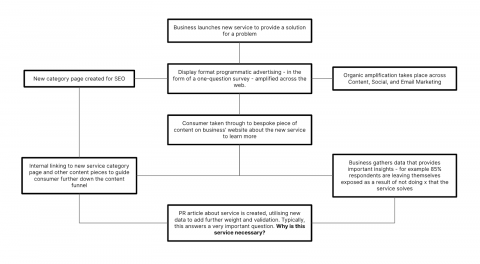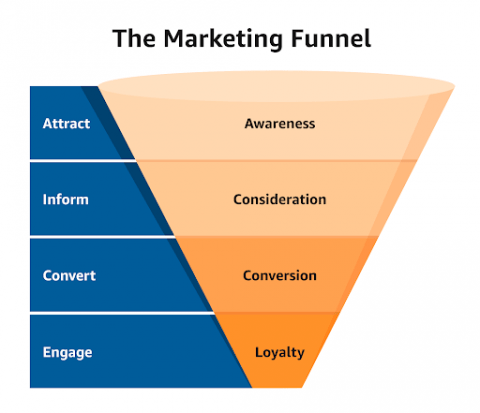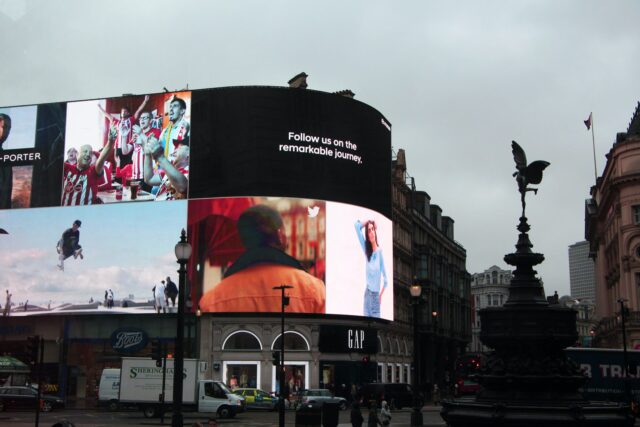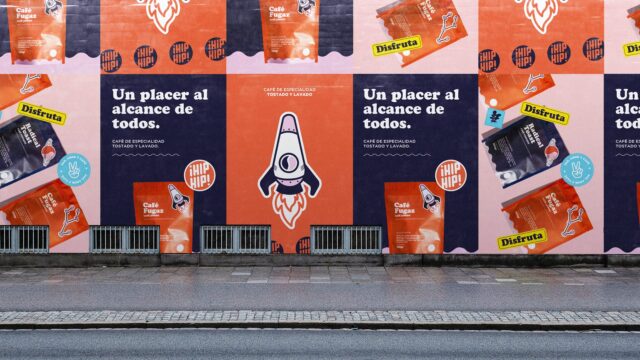So, you’ve read our guide to programmatic advertising and you’re all up to speed with what it’s best used for and how you can utilise it.
Your next step is to understand how programmatic advertising works as part of a full-funnel approach to your marketing strategy. To do this, it’s first important to understand how it works as part of the conversion journey.
How programmatic advertising works
While tactics like digital PR, social media, and email marketing have the ability to make a piece of content work as hard as possible, programmatic advertising will give you an extra edge, ensuring it’s getting in front of the right audience around the web, based on their interests and online activity.
Programmatic advertising supercharges skilful storytelling that should also play out over the rest of your marketing strategy but with a crystal clear call to action for a consumer: to click and engage with a piece of content that is helpful to them.
Whilst it boils down to who you’re targeting and what you’re trying to achieve, we’d suggest running top-of-the-funnel brand awareness campaigns to target a broad audience, to begin with. That data can then be collected as a remarketing list for you to target with a lower-funnel conversion message, pushing them toward a Call To Action (CTA) such as ‘Shop Now’.
Programmatic advertising also allows marketers to be far more considerate with their content strategy. By analysing our target audience based on their interests and actions, that data can help educate the type of content we need to create and how to best tailor it to what they’re looking for at that precise moment.
But what does this look like in a practical scenario? If a business was launching a new service and wanting to amplify it, they could embrace the following strategy:

In this example, the inclusion of programmatic advertising as part of the amplification strategy is two-fold:
- First-party data has been secured that can be utilised to educate the business in further decision-making and content creation
- The target audience has been driven to an informative piece of content on the business’ website that provides further insight and is set up in a way that guides the consumer to either the new category page or further relevant content via internal linking support
From top to bottom: how programmatic advertising works across the customer journey
Over three phases, this is how a customer’s content journey could look.
Phase 1
Your first stop is the awareness phase, addressing how we make the launch of the service as visible as possible to a broad audience that might invest in it.
As part of this, you may use programmatic advertising in the form of a short video to engage the targeted demographic with something visual and impactful and link it back directly to a product, service, or category page that has been specially created as the clear CTA and location we’re wanting to rank on Google. Digital Out-Of-Home (OOH) advertising – ads in prominent and relevant footfall locations – also come into play in this phase to keep your message and service top of mind.
Phase 2
Next, we’re thinking about potential customers in the consideration phase: those people who now know about your service and are looking for more information.
Through native advertising – something that doesn’t look like an advert at all as you’re scrolling – content can be designed to fit in seamlessly, wherever a user is browsing.
In this example, it could look like a sponsored article about the benefits of that new service. And once clicked on, it will guide the consumer to a designated blog page that has been built for Organic purposes, like SEO ranking and amplification via social media and email channels.
Phase 3
Finally, we’re looking at what content we can create that will get that customer ‘over the line’ in the conversion phase. With Display Ads, which utilise quality creative and clever, eye-catching copywriting, we’re specifically targeting our prime audience with ads with the purpose of influencing a decision. In this case, it’s for the audience to click on the ad with a view to purchasing or subscribing.
Using programmatic advertising to build brand awareness
Although historically Paid Media was considered more so for the conversion stage of the marketing funnel, the reality is that all brands should use it as a brand awareness tool.
How many times do you see an advert from delivery services, like JustEat and Deliveroo? They’re not necessarily there to encourage the consumer to buy a takeaway at that very moment in time but they are making sure their brand and their services are at the front of your mind when you make that decision to order food (and let’s be honest, for the large majority of us, that’s an inevitability).
Many brands are now switching up the way they use multi-channel programmatic advertising to showcase their brand values and focus on social messaging, like body positivity, taboo topics and issues society cares about.
Programmatic case study: National Geographic
National Geographic’s #SaveTogether campaign used programmatic advertising to raise awareness of endangered species
National Geographic created a user-generated marketing campaign using Digital Out-Of-Home with the aim of saving species that are at risk in the wild.
For the #SaveTogether campaign, members of the public could take a selfie with an image of an endangered animal, and post their photo on Twitter and Instagram using the campaign’s hashtag. 175 of these selfies were then projected on billboards in New York Times Square.
Understandably, Times Square has a huge volume of footfall so, for a singular location, you’re looking at a very premium spot in this instance.
This type of activity is brilliant because it goes on to generate great PR for brands, and they continue to be written about and published in news sources organically, furthering their brand awareness.
This, right here, is a unified brand and message campaign executed to the highest quality.
Are you using programmatic advertising as part of your content strategy?
There are lots of different programmatic advertising formats to support a full-funnel marketing strategy. It allows us to learn about our audience, find out what they engage with, and you’re in a position to provide them with content that is aligned with what they need or want to see.
Do you need help incorporating programmatic advertising into your marketing strategy? Get in touch.




